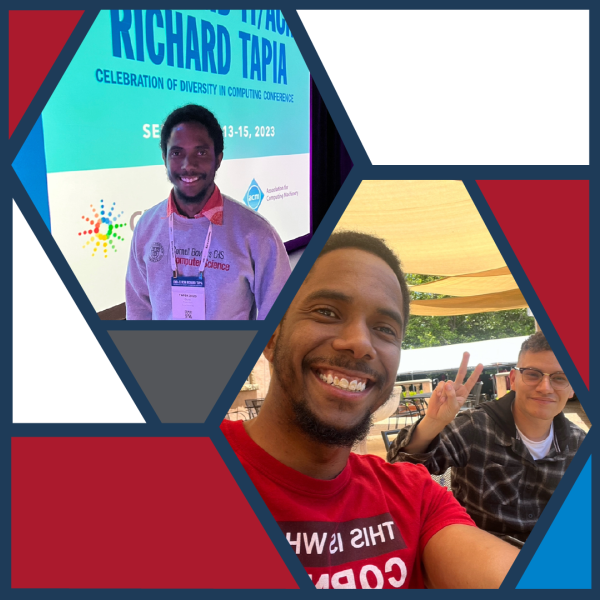November 8, 2023
By Patricia Waldron
Gloire Rubambiza, a doctoral candidate in the field of computer science in the Cornell Ann S. Bowers College of Computing and Information Science, is tackling a tough problem: How to develop the technology for digital agriculture – sensors, software, and communication networks for digitizing and automating agricultural work – when farming communities often have poor internet connectivity.
“Historically, rural areas have not had as good support in terms of networking, maintenance, and repair,” Rubambiza said. “How do you build technical systems in such an environment?”
With advising from Hakim Weatherspoon, professor of computer science, and Phoebe Sengers, professor of information science and science & technology studies, Rubambiza’s research straddles both the technological challenges of building reliable digital ag systems and the related social impact in rural communities. He presented this work at a doctoral consortium at the Richard Tapia Celebration of Diversity in Computing Conference, held Sept. 13-15 in Dallas. His talk was voted Best Doctoral Presentation by a panel of judges.
The Tapia Conference is the “premier venue to acknowledge, promote, and celebrate diversity in computing,” according to its website. Each year, the Office of Diversity, Equity, and Inclusion at Cornell Bowers CIS sends a delegation of students, staff, and faculty. This year’s contingent included five faculty, 30 undergraduates, 10 graduate students, and eight staff members, with student registration and travel costs covered by the college.
A scholarship from J.P. Morgan enabled Rubambiza to attend the conference – his third time – and participate in the thesis presentation competition. He said presenting to people outside of his field and receiving input on possible future research directions were incredibly valuable experiences.
“It was really good to present and get feedback on where I want to take the work next,” he said. Rubambiza plans to defend his Ph.D. in summer 2024. He ultimately hopes to make a career in research as a university professor.
One part of Rubambiza’s doctoral work has been to develop a software-defined farm (SDF) platform that integrates data from sensors, a computer that stores and analyzes the farm data, and devices or people that initiate a response on the farm – such as turning on the irrigation system when the moisture sensor indicates the soil is too dry. He designed the platform to be adaptable to a range of applications, capable of being scaled up, and reliable – even in rural areas with poor infrastructure. Rubambiza presented his work on the general SDF platform at the USENIX Annual Technical Conference in Boston in July.
For one SDF application, he teamed up with Fernando Romero Galvan, a doctoral candidate working with Katie Gold, assistant professor of grape pathology at Cornell AgriTech. They used spectroscopic imagery collected by NASA from planes to identify grapevine leafroll virus in vineyards. Romero Galvan developed plant disease detection models, which were hosted in the cloud infrastructure developed by Rubambiza, and were capable of detecting disease symptoms from the imaging with 86% accuracy. Multiple outlets publicized the work, including the Los Angeles Times, the Sacramento Bee, and NASA.
Next, Rubambiza is working with IBM Research, where he interned during the fall 2022 semester. Building on his published EdgeRDV work from the internship, he is trying to figure out how to scale up edge computing workloads – or in other words, how to transmit farm data and the results from analyses at the edges of the network, when internet connectivity is unreliable.
He is also looking for new ways to apply the SDF platform.
“We’re expanding and thinking more broadly on a global scale how to do this,” Rubambiza said. For example, he may be able to merge the spectroscopic data with evapotranspiration data from NASA satellites to identify signs of disease more accurately. Or, he could partner with animal science researchers to apply this technology to track diseases in livestock.
“There’s plenty of green grass to explore in this area,” he said.
Patricia Waldron is a writer for the Cornell Ann S. Bowers College of Computing and Information Science.



